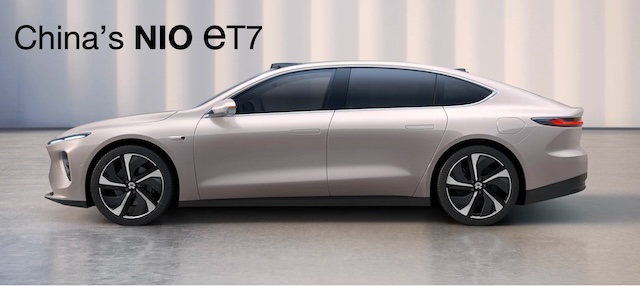Missing the Point – Why all-electric cars aren’t selling as well as they should
The car in the featured image is the all-electric NIO eT7. It’s pricy, particularly for the model with a maximum range of 621 miles per charge. It’s China’s answer to the Tesla, but not what America needs.
I want to save the earth as much as the next guy. Maybe more. And yet, when it came time for me to buy a new car last fall, I bought a gasoline-powered one – after conducting an exhaustive survey of all-electric car options out there.
There are currently four options: gasoline-powered cars, all-electric cars that you plug in to recharge, and two kinds of hybrids powered by electric and gasoline motors. There are the hybrids you plug in to recharge the battery and the kind, like the Toyota Prius, that use the energy from “regenerative braking” and their gas engines to recharge. In my opinion, hybrids are mechanically overly complicated. Emotionally, they’re a compromise for people who can’t commit and can’t make up their minds. I’m either going all-electric or not.
I really like the idea of buying an electric car. In a perfect world, I’d want a modified gull-wing DeLorean powered by a “Back to the Future” “Mr. Fusion” automotive reactor, but they’re not out yet. The question is, why didn’t I buy an all-electric this time?
The usual reason that you’re probably expecting to hear is that they are too expensive. The average price for new EVs, the all-electric kind from the top ten best-selling brands, is currently $55,758. That’s more money than I wanted to spend and most of the lower-priced options couldn’t drive 300 miles before running out of juice.
A friend of mind scoffs at my fixation with distance per charge. He has a point, sort of, given that, according to a 2021 study by the Department of Transportation’s Federal Highway Administration, the average American drives only thirty-seven miles a day. But then last weekend I drove down to see my daughter and grandchildren in Virginia. That’s 156 miles each way or 312 miles total. I’d have to hang out at Sheetz or Walmart, wherever there are chargers, for at least half an hour to make sure I didn’t run out of power or spend more time looking at my charge level than at the road on my way back.
The new car I bought has a combined city/highway range of 400+ miles and only takes, maybe, five minutes to fill up. So, I bought a quality gas-powered car that costs ten to fifteen thousand dollars less than its all-electric counterpart. It’s a decision made by roughly 84% of all new car buyers in 2023. Despite sizable federal tax credits, only 16% of new cars purchased in 2023 were electrified and half of those were hybrids.
The movement to electrify passenger car travel has been unimpressive at best.
But then price and range were not the primary reasons I didn’t go electric. My primary reason was that I can’t tolerate the lack of creativity and competitive options the major Western automakers have given us.
For one thing, Western automakers have grossly under-invested in fuel cell technology. A fuel cell is an established technology that uses virtually free hydrogen to make electricity, without combustion, to power a car’s electric motor. When you need to recharge, just pull into a fuel cell-proficient service station and swap out your fuel cell. The whole process should take about the same time as refilling your gas tank. Not incidentally, because you never own the fuel cell, the re-sale and trade-in value of your fuel cell car won’t depreciate the way an aging all-electric EV will. Sooner or later, the next buyer of your conventional EV is going to take the cost of buying a new battery into account. Watch what happens to your trade-in or resale value then. Conventional EV batteries lose power every year. That doesn’t happen if you don’t own the battery.
For another thing and more importantly, America is running well behind the Chinese in two very important aspects of passenger vehicle electrification. NIO, for example, a leading Chinese manufacturer of electric cars, has a battery with a range of 611 miles or 1000 kilometers. Why don’t we? Because our government isn’t allowing the Chinese to sell their cars in the United States – competition from which would encourage US auto battery and EV car manufacturers to do better.
“Can’t we buy Chinese electric cars in the United States?”
No. Because President Biden thinks that he’s protecting American-based car manufacturing and Donald Trump likens the sale and, heaven forbid, manufacture of Chinese cars in the United States as the equivalent of an all-out invasion.
Is the 641-mile battery more expensive? No, because the manufacturer of these Chinese cars doesn’t sell them. NIO sells their EVs without any battery in them in favor of a program whereby customers trade their spent batteries for fully charged replacements at roadside service centers. “Battery swapping,” as the program is called, makes the EV more affordable and there are no aging batteries in your car to reduce its resale or trade-in value.
Why aren’t American car manufacturers doing battery swapping? One reason is the lack of competition in the US with the Chinese.
And then there is the poor choice of industry-targeted consumers and new product functionality. To date, American designing of electric cars has been almost entirely about making EVs for the middle and top end of the market, Tesla being the prime example. EVs available in America are the equivalent of their gasoline-powered counterparts that have been superficially remarketed for electrification.
“All-electric cars are just conventional gas cars with high-tech dashboards.”
You’re right. Here’s a suggestion… Focus on a new concept, radically designed, super-safe two and four-passenger small cars with minimum frills, bells, and whistles. The objective is to get from A to B, safely and cost-effectively without polluting the environment. Yes, you can build a small car that’s safe for traveling on the beltway, highway, and country roads. And that’s practical for routine trips to the grocery store and most other common roadway adventures.
We live in an age of functionality. Our continuing egocentric fascination with the cars we drive is silly, anti-earth, and over, whether we like it or not.
What we need are small all-electric cars that sell to single people and couples, as second vehicles in families where the primary vehicle is gas-powered, that are affordable to lower-middle and lower-income families. Small cars that will sell for under $20,000 with a range of 300 to 400 miles. Think in terms of radically redesigned EVs that use the replaceable battery model the Chinese have adopted. Just because we didn’t think of it first doesn’t mean it’s not a better idea. They’ll sell like crazy and that’s when the transition to electrified cars picks up the pace – from the bottom of the market up, not from the top down.
And for heaven’s sake, President Biden, replace the current tax credit with a comparable discount that increases sales. Discounts work, same-year tax credits are far less appealing and the cost to the government is the same.

Les Cohen is a long-term Marylander, having grown up in Annapolis. Professionally, he writes and edits materials for business and political clients from his base of operations in Columbia, Maryland. He has a Ph.D. in Urban and Regional Economics. Leave a comment or feel free to send him an email to Les@Writeaway.us.

